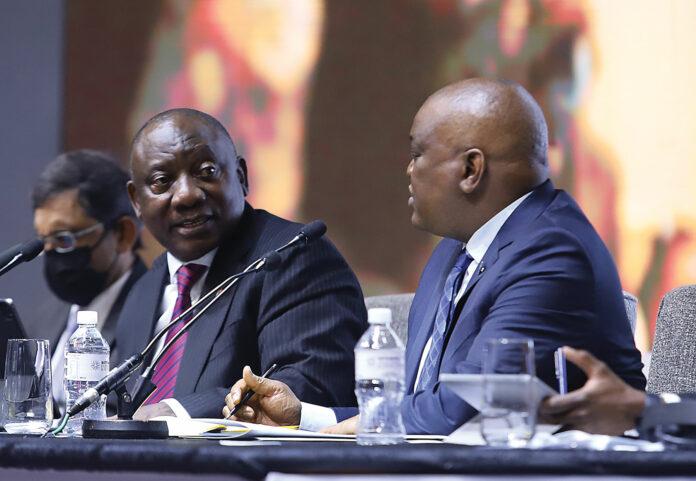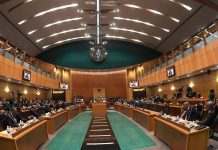Africa-Press – Botswana. When it comes to trade relationship between Botswana and South Africa, unfair arrangements have long been normalised in the name of Southern African Custom Union despite early signs that for the former, the arrangement is irreconcilable with its industrialisation targets. While smaller nations like Botswana generally have little choice, can there be a good pact if such a small nation is neighbour to a bigger economy? In short, what should a good trade pact look like? This is a difficult question that President Mokgweetsi Masisi attempted to answer in not so many words at the recently Botswana-South Africa trade Business Forum Roundtable held in Gaborone which was also attended by his counterpart, Cyril Ramaphosa.
While he did not put it this way, for Masisi, a truly bilateral trade pact would be the kind where South Africa recognises Botswana as an equal partner and vice-versa. In his words, the trade landscape between Botswana and South Africa that remains skewed in favour of the latter should drastically be reversed.
“It is a worldwide conceptual commonplace that products from bigger and more industrialised economies will dominate trade markets of the non-industrialised countries. It is, however, my ardent hope that the monopolistic industrial and commercial dominance will not persist indefinitely in the international markets or become the dominant factor in the relations between sisterly nations such as our two countries”, Masisi told his audience that included Ramaphosa at the GICC.
In short, Masisi said the two countries must ensure that the Botswana economy, which is less industrialised compared to South Africa, should be given an equal opportunity to industrialise.
From Masisi’s corner, or that of anyone vying for a shift in the direction and volumes of trade, anything short of this would be counter-productive for both parties. But this would be because big sister South Africa insists on maintaining a trade landscape skewed in her favour.
While he calls for a reversal of what has been going on for the past 28 years, Masisi says such can be done without necessarily taking away what South Africa has already built. The target, he said, is to develop value chains to unlock opportunities for new and existing companies in the private sector.
“We intend to identify new sectors from the regional and continental product space, which can successfully be wholly produced or grown in the country to form part of the value chain”, said Masisi.
But what does Masisi’s counterpart think? In his opening remarks, Ramaphosa said very little on the subject matter except that, “South Africa is committed to supporting our partners on the continent to reach their industrialisation goals.”
He also noted that the development of value-chains can also move the Southern African Customs Union (SACU), which both SA and Botswana are members of, towards a brighter new future of joint investment and development.
“I am also pleased to note that work is underway in SACU on a Work Programme on Industrialisation to promote industrial development and regional value chains, export promotion, investment attraction and promotion”, Ramaphosa said.
The need to redirect…
While Ramaphosa, atleast based on his GICC speech seems to be skewed towards helping Botswana at a customs union (SACU) as opposed to bilateral level, trade figures shows an increasingly unsustainable one-sided trade between the two neighbours which has since have provoked calls for a partnership of equals.
According to Masisi, the negative trade balances runs into billions of Pula for each year. He shared that between 2017 and 2021, Botswana exported to South Africa goods worth P31 billion, while it imported goods worth P210 billion. This means that, on average, Botswana is importing P42 billion and exporting only P6 billion worth of goods per annum.
“All these figures do reflect trade deficits or negative trade balances confirming my earlier statement. Those who doubt can do the calculations. The products we export include diamonds, beef, soda ash, and those we import include cereals, vehicles, and beverages, just to mention a few. Let me hasten to say, this needs to be reversed”, said Masisi.
In Ramaphosa’s account, between January 2003 and December 2021, nine Foreign Direct Investments projects from Botswana to South Africa were recorded. He also shared that they attracted capital investment worth R3.9 billion, resulting in the creation of over 2,000 jobs. Is he happy about those levels?
“We would like to see these numbers grow exponentially”, Ramaphosa said.
An analysis of the direction of trade by Statistics Botswana shows that during the month of May 2022, South Africa supplied Botswana with imports representing 63.4 percent (P5, 315.0 million) of total imports. This entailed Fuel; Food, Beverages & Tobacco and Diamonds which contributed 22.4 percent (P1, 188.0 million), 15.7 percent (P831.8 million) and 14.6 percent (P777.8 million) to total imports from that country, respectively. Machinery & Electrical Equipment and Chemicals & Rubber Products, followed with 13.3 percent (P706.8 million) and 11.3 percent (P601.9 million) respectively. Still in May 2022, South Africa received only 6.3 percent (P557.3 million) of total exports from Botswana. This reflects an imbalance, which according to Masisi has been going on for the past 28 years if not more.
The pressure to redirect…
As it stands, a few key pressures are likely to shape future Botswana-South Africa trade pacts. In the light of the African Continental Free Trade Area agreement, which encompasses most of Africa, future trade deals between the two neighbouring countries will probably be more multilateral (as opposed to bilateral) hence more comprehensive. This means Botswana can now look into forging a variety of economic partnerships with other countries away from South Africa. Already in terms of fuel importation, Botswana has existing arrangement with another neighbour, Namibia and another southern African nation, Mozambique. Infact, state owned Botswana Oil is set to establish fuel storage facilities at Mozambican and Namibian ports with an aim to double the country’s strategic oil reserves. According to Energy ministry deputy Permanent Secretary, Nchena Mothebe, existing strategic storage facilities in Botswana, which are mainly fed by South African refineries can carry the national demand for 15 days without additional supply, but the coming on board of the Mozambique and Namibia facilities would mean Botswana collectively hold 30-day stock. Botswana consumes approximately 100 million litres of various fuels each month and receives nearly all of its supplies from South Africa.
In their opening remarks, both Masisi and Ramaphosa emphasised the importance of the African Continental Free Trade Area agreement.
“The AfCFTA brings an opportunity for all of us to embrace. Therefore, we hope that we will work together to harness the opportunities that lie ahead, and take advantage of the existing manufactured products to be availed for value chains”, said Masisi.
For his part, Ramaphosa said that new markets in West, East, North and Central Africa hold immense potential for both South Africa and Botswana.
“We will be able to produce and export local goods, products and services to our fellow African countries that would otherwise be sourced from outside the continent”.
Moving forward, it is clear after the business forum what a new trade deal between the two neighbours should entail: For Botswana, It must offer an opportunity to industrialise. For South Africa, it must provide the chance to rid itself of an international trade policy that quashes job-creation for her neighbours and hinders efforts to stem economic integration.
For More News And Analysis About Botswana Follow Africa-Press






